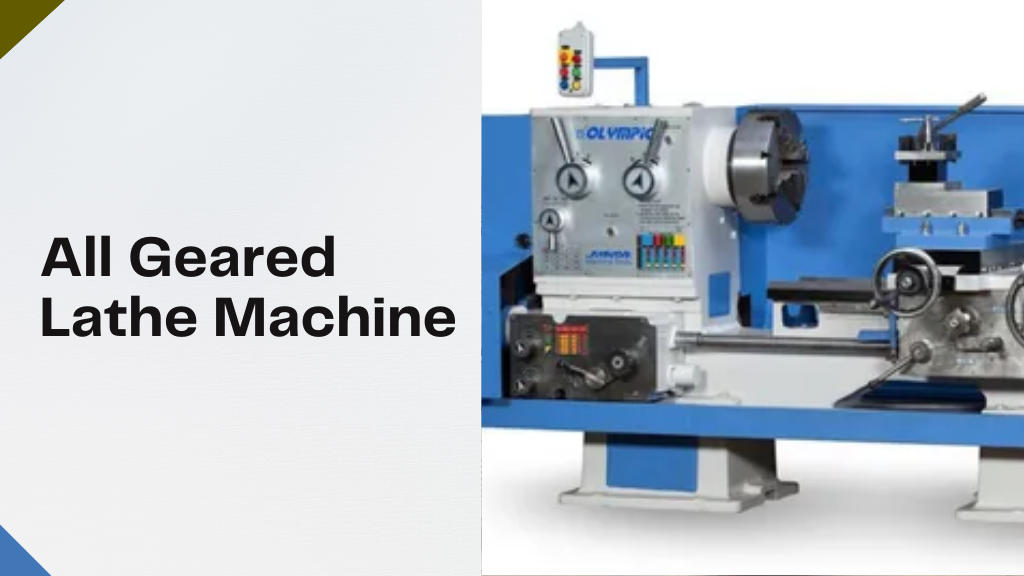In the world of metalworking and precision machining, the all geared lathe machine stands as one of the most versatile and reliable tools available. Unlike conventional lathes, these machines offer enhanced flexibility, precise control, and superior durability, making them essential in industries ranging from automotive to aerospace.
In this article, we explore everything about all geared lathe machines, from their mechanisms to their applications, helping professionals and enthusiasts make informed decisions. We also provide guidance on choosing the right machine for your workshop, understanding the gear mechanism, and maintaining it for long-term performance.
What is an All Geared Lathe Machine
An all geared lathe machine is a type of lathe that operates entirely through a gear system rather than using belts or pulleys. This design allows for precise speed control across multiple operations, enhanced torque transmission especially for heavy-duty cutting, simplified threading operations with uniform accuracy, and long-term durability as gear systems endure higher loads better than belts.
Unlike conventional lathes, which rely on belt drives that can slip and reduce efficiency, all geared lathes use interlocking gears to transmit power from the motor to the spindle. This ensures consistent rotational speed and smooth operation during complex machining tasks. The machine is particularly suitable for high-precision work where speed control and accuracy are critical.
All geared lathes are widely used for turning, facing, threading, and tapering operations. They are a favorite in workshops that handle materials such as steel, aluminum, brass, and other metals. The combination of power, precision, and stability makes these machines a top choice for professional machinists.
How Many Gears Are in a Lathe Machine
The number of gears in an all geared lathe machine depends on its size, design, and purpose. Typically, small to medium-sized machines contain between 10 to 20 gears, while heavy-duty industrial lathes may have 30 to 50 or more gears. Each gear is designed to perform specific functions in transmitting power and controlling speed.
The gears in an all geared lathe machine can be categorized as follows:
- Spindle gears, which control spindle rotation and determine the speed of the cutting tool.
- Change gears, which allow threading and pitch adjustments for different workpiece requirements.
- Feed gears, which regulate the movement of the carriage and cross-slide to ensure smooth machining.
The combination of these gears enables the operator to perform various tasks with precision, including turning cylindrical parts, cutting threads of different pitches, tapering workpieces, and performing intricate facing operations. The total number of gears also influences the versatility of the lathe machine, as machines with more gears typically provide greater flexibility in speed, feed, and threading options.
Understanding the All Gear Mechanism in a Lathe
The all gear mechanism in a lathe is what differentiates it from other lathe types. It is designed to provide consistent power transmission, precision, and efficiency. Here is a detailed look at how the mechanism works.
-
Gear Train System
A typical all geared lathe uses a gear train system consisting of spindle gears connected to the motor, intermediate gears for speed adjustment, and lead screw gears for threading operations. This system ensures smooth transmission of power even under heavy loads, allowing the operator to machine hard materials without losing speed or accuracy.
-
Lead Screw and Feed Rod
The lead screw is engaged through the gear mechanism for thread cutting, while the feed rod controls the automatic movement of the carriage during turning operations. This gear-driven interaction ensures uniform feed rates, high precision in threading, and minimal backlash. The lead screw and feed rod combination also enables the lathe to perform both longitudinal and cross-feed operations efficiently.
-
Quick Gear Shifting
Advanced all geared lathe machines feature quick-change gearboxes that allow operators to switch between different threading pitches or feed rates rapidly without stopping the machine. This capability significantly improves productivity and reduces setup time. Operators can change the threading operation from coarse to fine pitches with minimal effort, making these machines highly adaptable for diverse workshop tasks.
-
Gear Materials and Quality
The durability and efficiency of the all geared lathe depend on the quality of the gears. High-quality gears are usually made of hardened steel or alloyed metals and are precision-ground to reduce wear and noise. Proper lubrication and maintenance of gears further enhance the performance and lifespan of the lathe machine. Well-designed gear mechanisms also minimize vibration during heavy cuts, which improves surface finish and dimensional accuracy.
Types of All Geared Lathe Machine
All geared lathe machines come in several varieties, each suited for different applications. Choosing the right type depends on the workpiece size, material, precision required, and production volume.
1. Engine Lathes
Engine lathes are versatile and widely used for general-purpose machining. They are suitable for small to medium workshops and can handle a variety of materials and turning operations. These lathes offer moderate speed and feed control, making them ideal for most industrial tasks.
2. Heavy-Duty Industrial Lathes
Heavy-duty industrial lathes are built for high torque and rigid construction. They are used in automotive, aerospace, and heavy engineering industries to machine large shafts, rollers, and components. These machines can handle heavy cuts and operate continuously under demanding conditions.
3. Toolroom Lathes
Toolroom lathes are designed for high precision and accuracy. They are perfect for manufacturing intricate components, dies, and molds. Toolroom lathes provide excellent surface finish and allow machining of small tolerances with precision.
4. Automatic All Geared Lathes
Automatic lathes feature motorized feed and threading capabilities, reducing operator fatigue and increasing production speed. These machines are commonly used in mass production environments where repetitive tasks are required. Automatic all geared lathes also provide consistent results with minimal supervision.
Each type of all geared lathe has its advantages, and understanding the specific needs of the workshop is essential for selecting the best model.
Advantages of an All Geared Lathe Machine
Investing in an all geared lathe brings multiple benefits, making it a valuable asset for workshops and industrial setups. These machines are ideal for operations that demand precision, durability, and versatility. Choosing the right lathe can significantly improve productivity and product quality.
-
High Precision
Gear-driven mechanisms eliminate slip, ensuring consistent and accurate machining. This precision is essential for complex operations and intricate components. High accuracy reduces errors and minimizes material waste.
-
Durability and Robustness
All geared lathes are built to handle heavy loads without excessive wear or vibration. Their solid construction allows for continuous operation under demanding conditions. This makes them suitable for heavy-duty industrial applications.
-
Flexible Speed and Feed Control
Multiple gears provide variable speeds and feeds, allowing operators to adjust settings for different materials and cutting operations. This flexibility improves efficiency and ensures optimal machining results.
-
Enhanced Threading Capability
All geared lathes support a wide range of threading pitches with high accuracy. This makes them ideal for producing threaded components for various industries. Accurate threading reduces rework and enhances product quality.
-
Reduced Maintenance
Gear-driven systems are less prone to wear compared to belt-driven lathes. Fewer moving parts mean less frequent maintenance and lower operational downtime. This translates to cost savings over the life of the machine.
-
Long-Term Reliability
Properly maintained all geared lathes can operate efficiently for decades. Their robustness ensures they remain a dependable investment for long-term production needs. Industries like automotive, aerospace, and heavy machinery heavily rely on them.
How to Choose the Best All Geared Lathe Machine
When selecting the best all geared lathe machine, several factors must be considered to ensure optimal performance and suitability for your workshop.
-
Machine Sizeand Bed Length
Smaller machines are ideal for prototype work, toolmaking, and educational purposes. Larger machines are better suited for industrial applications and machining large components. The bed length and swing over bed dimensions should be chosen based on the size of the workpieces you plan to machine.
-
Gear System Quality
Check the quality of the gears, including material, hardness, and precision. Properly machined and hardened gears reduce backlash, vibration, and wear over time. Machines with well-designed gear trains provide smoother operation and more accurate results.
-
Motor Power
Ensure the motor has sufficient power to handle the cutting load and material type. Three-phase motors are recommended for heavy-duty industrial lathes, while single-phase motors are suitable for small workshops.
-
Threading Capability
Verify the available threading pitches and lead screw engagement options. Quick-change gearboxes enhance versatility and allow for easy adjustment of threads without extensive setup.
-
Brand Reputation
Reputable manufacturers provide warranties, spare parts, and after-sales service. Investing in a trusted brand reduces the risk of downtime and ensures long-term support. Consider companies that have a proven track record of quality and reliability in the machining industry.
-
Safety Features
Modern all geared lathes include safety features such as emergency stops, chip guards, and lubrication systems. Prioritize machines that comply with safety regulations to protect operators and reduce the risk of accidents.
Applications of All Geared Lathe Machine
Various industries use all geared lathes for precision machining. Some common applications include:
- Automobile Industry: Machining engine parts, shafts, gears, and brake components.
- Aerospace: Manufacturing precision components like turbine shafts and landing gear parts.
- Tool and Die Making: Creating molds, dies, jigs, and fixtures with high accuracy.
- Heavy Engineering: Turning large shafts, rollers, and mechanical parts for machinery.
- Educational Institutions: Teaching advanced machining techniques and practical applications.
- Small Workshops: Producing customized components for mechanical and fabrication projects.
The versatility of all geared lathes makes them suitable for both small-scale workshops and large industrial production lines.
Maintenance Tips for Longevity
Proper maintenance ensures that your all geared lathe machine operates efficiently for years. Key maintenance practices include:
- Lubricate gears regularly to prevent wear and tear.
- Check gear alignment to ensure smooth operation and prevent damage.
- Inspect lead screws and feed rods for smooth threading and movement.
- Clean chips and debris to avoid gear damage and ensure safety.
- Schedule periodic servicing according to manufacturer recommendations.
- Monitor spindle and motor performance to detect any issues early.
Regular maintenance improves machine lifespan, reduces downtime, and maintains precision in operations.
Common Challenges and Solutions
Even high-quality all geared lathes may encounter issues if not properly handled. Common challenges include:
- Gear wear due to heavy loads or poor lubrication. Solution: Use proper lubrication and monitor gear condition.
- Inaccurate threading caused by backlash. Solution: Regularly inspect and adjust gears and lead screws.
- Overheating during continuous operation. Solution: Ensure proper cooling and avoid excessive load.
- Vibration during heavy cuts. Solution: Use stable workholding and high-quality gears.
By addressing these challenges proactively, operators can maintain consistent performance and precision.
Conclusion
The all geared lathe machine is a cornerstone of modern machining, offering unmatched precision, durability, and versatility. Understanding its gear mechanism, applications, advantages, and maintenance requirements allows workshops and industrial operations to maximize productivity and component quality. Investing in a high-quality all geared lathe machine ensures long-term reliability, reduces operational costs, and improves machining accuracy for a wide range of materials and tasks.
Choosing the right model involves evaluating machine size, gear quality, threading capability, motor power, and brand reputation. Proper maintenance and regular inspections further enhance the lifespan and performance of the machine. Whether you operate a small workshop or manage a large industrial production line, an all geared lathe machine is a strategic investment for achieving precision and efficiency in machining operations.
Frequently Asked Questions
What is an all geared lathe machine used for
Industries such as automotive, aerospace, heavy engineering, and toolmaking use an all geared lathe machine to perform precision turning, threading, tapering, and facing operations.
How many gears are in a lathe machine
Depending on size and type, a lathe can have anywhere from ten to fifty or more gears, including spindle, feed, and lead screw gears.
What is the all gear mechanism in a lathe
The all gear mechanism uses interlocking gears to transmit power from the motor to the spindle and lead screw, providing precise speed control, uniform threading, and enhanced torque transmission.
How do I choose the best all geared lathe machine
Consider machine size, gear quality, motor power, threading capability, brand reputation, and safety features to select the most suitable model for your workshop.
Are all geared lathes better than belt-driven lathes
All geared lathes provide higher precision, durability, and flexibility, especially for heavy-duty and precision applications. Industries prefer them for operations that require accuracy and reliability.




